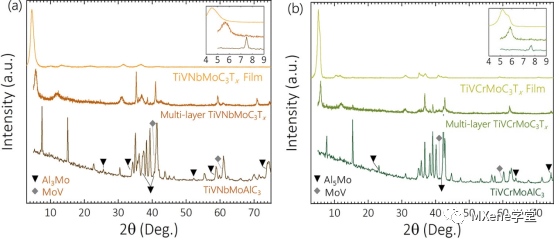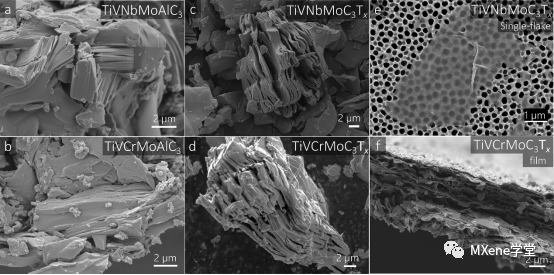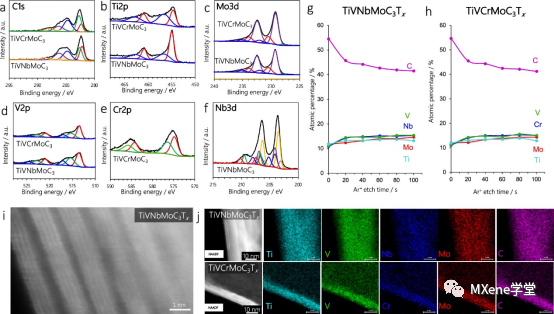
hotline£º
17715390137
Tel/Wechat£º
18101240246 (Technology)
0512-68565571
Email£ºmxenes@163.com £¨Sales Engineer£©bkxc.bonnie@gmail.com
Scan the code to follow or search the official account on WeChat:
2D Materials Fronrier After paying attention,
click on the lower right corner to contact us,
Enter enterprise WeChat.
Professional Services Online

Background.
Two-dimensional (2D) transition metal carbide and nitride (MXenes), is a rapidly growing two-dimensional material. The chemical formula of MXenes is Mn+1XnTx (n = 1-4), in which the 2D sheet consists of transition metal atomic layers with interlaced carbon / nitrogen layers, as well as different terminal groups, such as-O,-F and-OH. In the past decade, more than 30 kinds of MXene have been successfully synthesized, and many more have been studied by computational methods. But so far, the composition of MXene is still limited to one or two transition metals.
Full text guide.
In view of this, Professor Babak Anasori of Purdue University in the United States reported the synthesis of multi-element high entropy M4C3Tx MXenes for the first time by introducing four transition metals. Specifically, the author introduces two new types of high-entropy MXene, namely TiVNbMoC3Tx and TiVCrMoC3Tx, and their high-entropy MAX phase precursors: TiVNbMoAlC3 and TiVCrMoAlC3. The structure, phase purity and equal molar ratio distribution of four transition metals in high entropy MAX and MXene phases were studied by means of X-ray diffraction, X-ray photoelectron spectroscopy, energy dispersive X-ray spectroscopy and scanning transmission electron microscopy. And the synthesizability of these high entropy MAX phases is explored by using first-principles calculation to calculate the formation energy.The results also show that when three transition metals are used instead of four transition metals, two different MAX phases can be formed under conditions similar to those of four transition metals (i.e., there is no pure single-phase form). This discovery shows the importance of configuration entropy in the preparation of single-phase high-entropy MAX phase, which plays an important role in the synthesis of pure-phase high-entropy MXenes. The synthesis of high entropy MXenes greatly expands the composition diversity of MXenes family, and further expands the properties of MXenes in electronic, magnetic, electrochemical, catalytic, high temperature stability and mechanical behavior. The results of the related papers were published on ACS NANO on June 15, 2021 under the title of "High-Entropy 2D Carbide MXenes: TiVNbMoC3 and TiVCrMoC3".

Figure 1 shows a schematic diagram of the synthesis of high entropy MAX phase and MXenes. For the sintering of (a) high entropy MAX phase, the element powder mixture with equal stoichiometric molar ratio is sintered in an alumina crucible in a tube furnace. The picture on the left of (b) shows the MAX phase cell (M1M2M3M4AlC3) with elements Ti (pink), V (orange), Nb/Cr (blue), Mo (green), Al (red) and C (black). The picture on the right shows the synthesized MAX phase with a layered transition metal layer, which consists of four transition metal elements, and the aluminum (red) and carbon (black) atomic layers in the M4AlC3 MAX phase structure. (c) hydrofluoric acid selective etching of aluminum layer to synthesize multi-layer high entropy MXenes,MXenes the terminal group (Tx) on the surface is shown in yellow. Through the embedding of organic molecules, (d) can delaminate multi-layer MXenes to obtain monolayer high-entropy MXenes, namely TiVNbMoC3Tx and TiVCrMoC3Tx.

Figure 2 shows the XRD diagram of high entropy MAX phase and MXenes. The (a) TiVNbMoAlC3 MAX phase and the XRD diagram of the obtained TiVNbMoC3Tx MXenes. The (b) TiVCrMoAlC3 MAX phase and the XRD diagram of the obtained TiVCrMoC3Tx MXenes. The figure illustrates the diffraction peak change from the MAX phase precursor (bottom pattern) to the peeled multi-layer MXenes (middle pattern), and then to the layered single-layer or small-layer MXenes sheet (top pattern). The illustration of each picture illustrates the shift of the (002) peak during the evolution from the MAX phase to the single-layer or low-layer MXenes.

Figure 3 shows the SEM diagram of high entropy MAX and MXenes. (a) TiVNbMoAlC3 and (b) TiVCrMoAlC3 show the structure of typical MAX phase carbides. (c) TiVNbMoC3Tx and (d) TiVCrMoC3Tx are etched multi-layer MXenes powders with accordion-like morphology, which is formed by selective etching of Al layer from MAX phase in high concentration HF. Monolithic TiVNbMoC3Tx MXenes on (e) alumina substrate. (f) TiVCrMoC3Tx MXenes films were prepared by vacuum-assisted filtration.

Figure 4 shows the XPS, STEM, and EDS results of high entropy MXenes. (Amurf) XPS spectra of TiVNbMoC3Tx and TiVCrMoC3Tx. The relationship between the atomic percentage of two kinds of MXenes and the etching time of Ar+ measured in XPS shows that all kinds of atoms are uniformly distributed in the inner layer of MXenes. High-angle annular dark field (HAADF) STEM image of (i) TiVNbMoC3Tx MXenes. The HAADF STEM and EDS results of (j) TiVNbMoC3Tx (top) and TiVCrMoC3Tx (bottom) show the layered morphology and the uniform distribution of Ti, V, Nb/Cr, Mo and C elements.
Prospect.
In this paper, two high entropy MAX phases (TiVNbMoAlC3 and TiVCrMoAlC3) were successfully synthesized and transformed into high entropy MXenes (TiVNbMoC3Tx and TiVCrMoC3Tx) with equal molar ratio containing main transition metals. By using the traditional pressureless reactive sintering to form high entropy MAX phase, and using the selective etching based on hydrofluoric acid and the delamination method of tetramethylammonium hydroxide, two kinds of high entropy MXenes from single layer to few layers were synthesized. The successful synthesis and purity of high entropy MAX phase and monolayer and few layer high entropy MXenes etched by them were confirmed by XRD, SEM and STEM. In addition, the bonding properties of high entropy MXenes were confirmed by XPS, and the equal molar ratio distribution of transition metals in MXenes was further determined by EDS element mapping of STEM. Through first-principles calculation, the synthesizability of quaternary high entropy MAX phase is traced back to the stability driven by entropy, and the importance of high configuration entropy in the formation of pure phase and stable phase of multi-principal element MAX phase is emphasized. The successful integration of this peculiar high-entropy multi-principal element MXenes into a growing MXenes family increases the possibility to explore its applications in energy storage, catalysis and microstructure stability in extreme environments.
This research work lays a foundation for further research, and the focus of future research can be on the comprehensive analysis of the composition of more high-entropy MAX phases and their derived MXenes, in order to further analyze the stable composition by using computational and experimental methods. In addition, understanding the composition of each transition metal layer of MXenes can also play an important role in customizing their electrochemical, catalytic, electrical and magnetic properties in the future. Some choices of multi-component transition metals can further promote the development of topological insulator MXene. Although the topological insulator material has not been synthesized yet, it has been predicted in theoretical research.
This information is from the Internet for academic exchange only. if there is any infringement, please contact us to delete it immediately.

| Reminder: Beijing Beike New Material Technology Co., Ltd. supplies products only for scientific research, not for humans |
| All rights reserved © 2019 beijing beike new material Technology Co., Ltd ¾©ICP±¸16054715-2ºÅ |